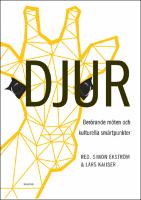DJUR
Berörande möten och kulturella smärtpunkter
| dc.contributor.editor | Ekström, Simon | |
| dc.contributor.editor | Kaijser , Lars | |
| dc.date.accessioned | 2019-06-20 10:39:43 | |
| dc.date.accessioned | 2020-04-01T10:17:40Z | |
| dc.date.available | 2020-04-01T10:17:40Z | |
| dc.date.issued | 2019 | |
| dc.identifier | 1005094 | |
| dc.identifier | OCN: 1126124389 | en_US |
| dc.identifier.uri | http://library.oapen.org/handle/20.500.12657/25007 | |
| dc.description.abstract | In this volume of studies, Animal: Moments of Affect, Moments of Pain, eight ethnologists apply a cultural perspective to people’s varied and complex relationships with other species. The contributions focus on wild animals, that is, those that are rarely found in the authors’ immediate vicinity. Based on ongoing research, the articles discuss themes such as conflicts and joys in the birdwatching world, charismatic animals in various exhibition contexts, children’s fears, morbid animal jokes and the ritual transformation of living animals into edible meat. The texts range from the tender, comical and cute to death and existential vulnerability. The book begins with the editors presenting an overview of how animals have been produced, noticed and studied in a mostly Nordic humanistic research context. Then the articles follow. Based on the idea of affective logic, Elin Lundquist follows the on-site monitoring of the bird hunting that takes place annually in Malta. Mattias Frihammar uses observations at a wilderness gallery with taxidermied animals to reflect on local identity. Lars Kaijser examines the ambivalent and conflicted portrayal of sharks in public aquariums. Sverker Hyltén-Cavallius writes about the death of extinct animals and how this is displayed in natural history museums. Susanne Nylund Skog examines birdwatchers’ stories as an expression of collecting and as a way of manifesting status. With lobster cartoons as a starting point, Simon Ekström shows how these depict both animal rights issues and human anxiety. Helena Hörnfeldt investigates animal fear and the diffuse boundary between humans and animals. Proceeding from different depictions of slaughter and the preparation of meat, Michelle Zethson problematizes how some animals are made edible. The volume ends with an epilogue by the editors commenting on the findings. | |
| dc.language | Swedish | |
| dc.subject.classification | thema EDItEUR::J Society and Social Sciences | en_US |
| dc.subject.classification | thema EDItEUR::J Society and Social Sciences::JB Society and culture: general | en_US |
| dc.subject.classification | thema EDItEUR::J Society and Social Sciences::JB Society and culture: general::JBC Cultural and media studies::JBCC Cultural studies | en_US |
| dc.subject.classification | thema EDItEUR::J Society and Social Sciences::JH Sociology and anthropology::JHM Anthropology::JHMC Social and cultural anthropology | en_US |
| dc.subject.other | human-animal relation | |
| dc.subject.other | culture | |
| dc.subject.other | narrative | |
| dc.title | DJUR | |
| dc.title.alternative | Berörande möten och kulturella smärtpunkter | |
| dc.type | book | |
| oapen.identifier.doi | 10.22188/kriterium.16 | |
| oapen.relation.isPublishedBy | 7b034f4a-b816-4718-88ac-63b24c8e4b24 | |
| oapen.relation.isbn | 9789170617607 | |
| oapen.pages | 272 | |
| oapen.place.publication | Gothenburg | |
| oapen.identifier.ocn | 1126124389 |

